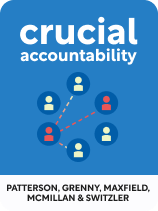

This article is an excerpt from the Shortform book guide to "Crucial Accountability" by Kerry Patterson, Joseph Grenny, et al.. Shortform has the world's best summaries and analyses of books you should be reading.
Like this article? Sign up for a free trial here .
Are you facing accountability issues at work or in a relationship? What should you avoid when talking about accountability?
The book Crucial Accountability helps readers recognize what not to do when discussing accountability issues. Many of these points can be used in other tough conversations too, not just for accountability issues.
Keep reading to tackle accountability issues in no time.
Discussing Accountability Properly
The authors stress the importance of understanding what not to do in an accountability conversation almost as much as what to do. Because we’ve likely grown up watching people handle accountability issues incorrectly, these learned behaviors slip out when we least expect them to. By understanding what not to do, we can recognize and halt these behaviors as soon as we see ourselves enacting them.
Before Giving Advice, Listen to the Other Person’s Perspective
The authors assert that we need to listen to the other person’s point of view in order to make accurate judgments and solutions when dealing with accountability issues. The issue is about the other person, therefore, they’re the ones who’ll have the most information about what went wrong and why.
Without hearing the other person’s perspective, you might be seeing the issue incorrectly or incompletely. For example, after hearing the other person’s side of the story, you might realize that their reaction was correct in that particular situation, even if they failed to meet expectations.
Don’t Bias Their Response
The authors warn that when you’re brainstorming solutions, don’t bias the other person’s response by first proposing a solution and then asking what they think. When you start off the discussion with something like “to solve this problem I think that it’s best to do X. What do you think?” you’re preventing new, and possibly better, solutions to enter the conversation.
The authors explain that this strategy stifles the production of new and better ideas in two ways:
- You’re putting ideas in the other person’s head which can stifle any new solutions they might have come up with.
- They might be hesitant to disagree with you.
Instead, the authors advise that you ask open-ended questions that don’t assume the solution.
| Don’t Use Leading Questions This practice is called asking with leading questions: Leading questions are defined as questions that lead or persuade the other person to give a certain response. These types of questions are banned from interrogations and research studies because of the effect they have on peoples’ responses. When you ask a leading question, it’s unlikely that you’ll receive the other person’s genuine, unbiased response. So, as the authors recommend, if you truly want to receive the other person’s opinions and the best possible solutions, avoid asking for their ideas with leading questions. |
Don’t Make the Other Person Guess What You’re Thinking
The authors explain that if you already have a solution in mind, don’t disingenuously ask the other person for their opinion until they eventually guess what you’re thinking. Doing so is disrespectful and manipulative—humans can’t read minds, so don’t expect them to.
Instead, the authors advise entering the conversation with an open mind and hearing the other person’s recommendations before adding your input. You can have ideas about possible solutions, but don’t enter the conversation with the belief that you already have the best solution. This is an important step in addressing accountability issues.
Don’t Cut the Conversation Short
Keep the conversation flowing honestly and freely. The more information you have, the easier it is to pinpoint the underlying cause of the key issue. With this information, you can better pinpoint an effective solution.
| How to Keep the Conversation Flowing The authors recommend that we keep the conversation flowing in order to achieve the best solutions; however, they don’t provide guidelines on how to do this. Experts suggest that we can have a successful and rewarding conversation by: 1. Making sure the conversation is roughly 50/50. Make sure you’re not speaking too much and dominating the conversation, or too little and forcing the other person to come up with irrelevant things to say to avoid awkward silence. 2. Using effective and active listening. Make eye contact and use nonverbal cues like nodding to encourage their response. Ask questions and reflect on information with comments like “I understand how you feel” or “that must have been difficult.” 3. Using reciprocal disclosure. When the other person discloses something personal, try to disclose something equally as personal. 4. Be positive so that the other person knows you appreciate their time spent talking with you. 5. Regulating the flow of conversation by using pauses to speak up, and once you’ve made your point inviting the other person to respond. |
Don’t Use Threats
The authors urge you to be aware of your motives when relaying natural consequences. If your intent is to threaten or intimidate the other person into doing what you want, they will likely react negatively.
Stop Talking When the Other Person Understands
When you believe you’ve reached a point where the other person understands the natural consequences and will comply, you can stop piling on more consequences. This may make the other person feel patronized, belittled, or discourage them from wanting to participate in future conversations.

———End of Preview———
Like what you just read? Read the rest of the world's best book summary and analysis of Kerry Patterson, Joseph Grenny, et al.'s "Crucial Accountability" at Shortform .
Here's what you'll find in our full Crucial Accountability summary :
- How to broach sensitive conversations with loved ones and coworkers
- How to prepare for, execute, and follow up on accountability conversations
- How to solve issues while improving your relationships






